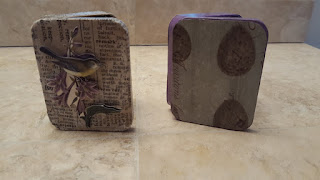I purchased these kits a couple of years ago with the intention of making wee-little house Christmas ornaments. In fact, they have hangers built into their chimneys for just such a purpose. I found, though, that my numerous attempts to work on them during the winter would generally end in frustrating creative roadblocks. The construction of the houses involved a lot of sit-and-hold-while-glue-dries, the designs never seemed to come together smoothly, and the results didn't pan out to look anything like the original concept I'd had in my head (as vague as it was to begin with). For me, the collage process involves a lot of "walk away and think about it", so perhaps Christmas is not the season for me to do collages in the first place. After the winter holidays came to a close, I turned to Pinterest for inspiration on Putz houses - traditional little cardboard house villages, which are usually covered in glitter, and generally put out at Christmas time, although I did find some themed for Easter. After the relative success of my altered tins, and remembering that I did complete one spring themed house last year, I thought I would apply the spring theme to the rest of my little Putzy houses.
I now have a wee village (which will grow by one house once I get the rest of the Easter decorations out of the attic)
The pink farm house was the first, and most frustrating, house to start with... frustrating only in that it was already assembled, but painted dark red and brown and I wasn't fond of how it looked at all. I repainted this house 3 times before I was satisfied with the color combination. The addition of window frames, a little flower garden, and a coating of the traditional Putz glitter finally finished this 2-year old project.
Bonus: finally using the little flower tabs my mom handed down to me.
With that success under my belt, I began digging through my paper stash, putting together color combinations, and picking out inhabitants for my little village. The map house came together quickly, as did the purple bird house. The tall gnome house gave me a little trouble, as I'd picked a nice realistic looking clover for the ground, and the swirly red for the roof, so the house needed to be dark... however none of my blue monochrome papers looked quite right. I set it aside for a couple days, then finally came across the bold stripes which seem to be just the right amount of dark and light to work.
I found that mod-podging all the pieces before assembly made for much easier work. I also gave up on my regular glue and attempted both double-stick tape and hot glue for the house assembly. The double-stick tape generally held the first couple houses together well, although one roof was not perfectly lined up, and so part of it kept popping up. so I eventually fixed it with hot glue. Also, the wee fences would not hold with tape at all, so those were fixed with hot glue as well. Hot glue held everything well, but is not very forgiving if you don't line it up right, and also has the possibility of burnt fingertips, so I would practice putting the pieces together a few times prior to applying the glue. That seemed to do the trick, and the few extra globs (which seem to be inevitable with hot glue) were easily removed with my xacto knife.
My favorites are my little church, and the red gnome house.
I found that mod-podging all the pieces before assembly made for much easier work. I also gave up on my regular glue and attempted both double-stick tape and hot glue for the house assembly. The double-stick tape generally held the first couple houses together well, although one roof was not perfectly lined up, and so part of it kept popping up. so I eventually fixed it with hot glue. Also, the wee fences would not hold with tape at all, so those were fixed with hot glue as well. Hot glue held everything well, but is not very forgiving if you don't line it up right, and also has the possibility of burnt fingertips, so I would practice putting the pieces together a few times prior to applying the glue. That seemed to do the trick, and the few extra globs (which seem to be inevitable with hot glue) were easily removed with my xacto knife.
My favorites are my little church, and the red gnome house.
This bird paper pack is among my favorite in my whole stash, and a bird themed church is appropriate for me.
I love the raindrop paper on this roof, and the flags on the fence, such a cheerful little gnome house!



























